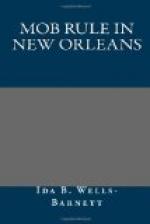The publisher hereof does not attempt to moralize over the deplorable condition of affairs shown in this publication, but simply presents the facts in a plain, unvarnished, connected way, so that he who runs may read. We do not believe that the American people who have encouraged such scenes by their indifference will read unmoved these accounts of brutality, injustice and oppression. We do not believe that the moral conscience of the nation—that which is highest and best among us—will always remain silent in face of such outrages, for God is not dead, and His Spirit is not entirely driven from men’s hearts.
When this conscience wakes and speaks out in thunder tones, as it must, it will need facts to use as a weapon against injustice, barbarism and wrong. It is for this reason that I carefully compile, print and send forth these facts. If the reader can do no more, he can pass this pamphlet on to another, or send to the bureau addresses of those to whom he can order copies mailed.
Besides the New Orleans case, a history of burnings in this country is given, together with a table of lynchings for the past eighteen years. Those who would like to assist in the work of disseminating these facts, can do so by ordering copies, which are furnished at greatly reduced rates for gratuitous distribution. The bureau has no funds and is entirely dependent upon contributions from friends and members in carrying on the work.
Ida B. Wells-Barnett
Chicago, Sept. 1, 1900
MOB RULE IN NEW ORLEANS
+Shot an officer+
The bloodiest week which New Orleans has known since the massacre of the Italians in 1892 was ushered in Monday, July 24, by the inexcusable and unprovoked assault upon two colored men by police officers of New Orleans. Fortified by the assurance born of long experience in the New Orleans service, three policemen, Sergeant Aucoin, Officer Mora and Officer Cantrelle, observing two colored men sitting on doorsteps on Dryades street, between Washington Avenue and 6th Streets, determined, without a shadow of authority, to arrest them. One of the colored men was named Robert Charles, the other was a lad of nineteen named Leonard Pierce. The colored men had left their homes, a few blocks distant, about an hour prior, and had been sitting upon the doorsteps for a short time talking together. They had not broken the peace in any way whatever, no warrant was in the policemen’s hands justifying their arrest, and no crime had been committed of which they were the suspects. The policemen, however, secure in the firm belief that they could do anything to a Negro that they wished, approached the two men, and in less than three minutes from the time they accosted them attempted to put both colored men under arrest. The younger of the two men, Pierce, submitted to arrest, for the officer, Cantrelle, who accosted him, put his gun in the young




